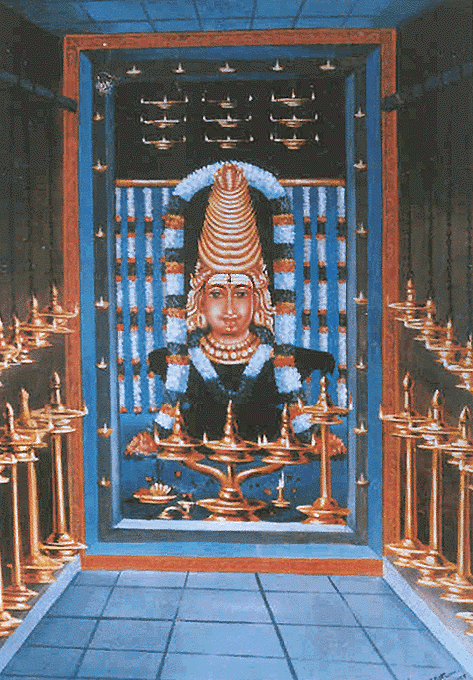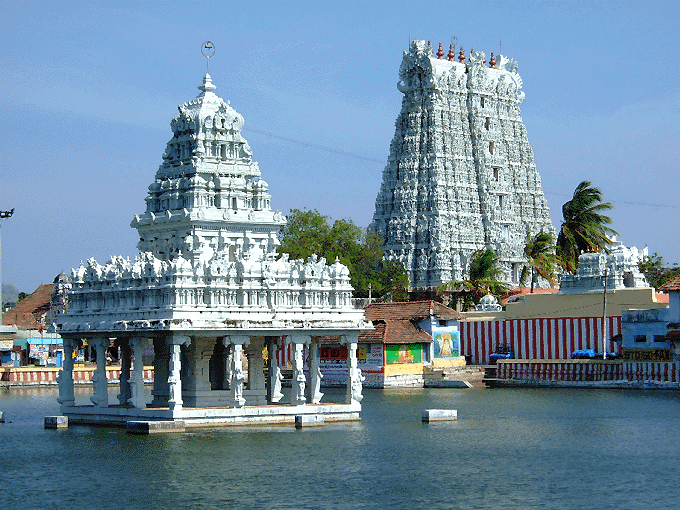
|
|
|
|
Once arriving in the village of Suchindram, 14 kms. from the town of Kanniyakumari, devotees and visitors walk up a commercial corridor that leads to the temple complex. A large temple tank spreads out to the right, with the towering gopuram ahead. 134 feet in height, the seven-storied construction is an excellent example of classic South Indian temple architecture. The (usually) unpainted stone gopuram is intricately and amazingly carved into thousands of high relief, exquisitely rendered images of deities, transcendental pastime scenes, and various 9th century inscriptions. The play of light on the multi-faceted gopuram makes it a brilliant and beautiful structure.
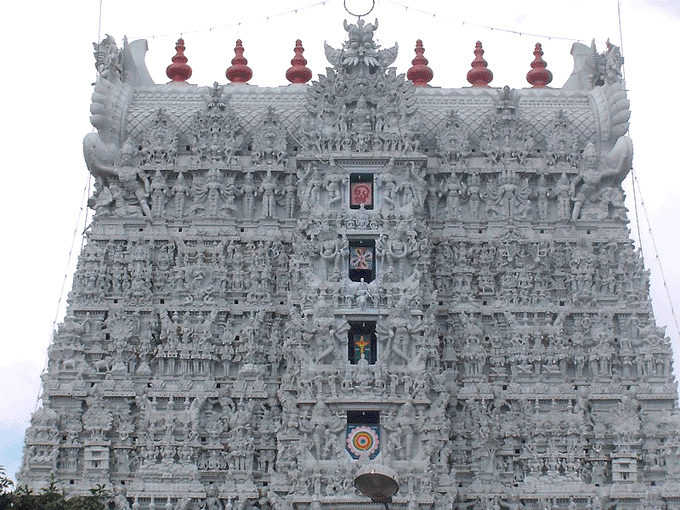
Top of gopuram Both Vaishnavas and Shaivites flock to this temple, which has a rich Puranic history, including an interesting pastime involving Lord Brahma. The Sage Atri lived here with his wife Anasuya, who was considered a very chaste woman. Lord Brahma, Siva, and Vishnu visited her once during the absence of her husband, hoping to test and prove her chastity. They arrived as sannyasis asking alms and begged Anasuya to feed them, but told her that they had taken a vow under which they could not accept alms from a person wearing clothes. It was a sin to refuse alms to mendicants, but the chaste Anasuya was not baffled. She simply offered prayers on the matter, then sprinkled paatha theertham on the three beggars, transforming them into three small babies. She then disrobed and fed them. The Goddesses Saraswati, Laksmi and Parvati then intervened, and the three babies were restored to their normal forms. As the divine personalities departed, the deities remained behind, manifesting in the form of Swayambulingas, which sprouted under an Amaltas tree. This tree, the Sthala Vriksham, has been dated to approximately 2,500 years old. The tree is now decaying and hollow, and it has been preserved by a meticulous metal plating. Within the hollow trunk are the three separate linga, for Lord Brahma, Lord Visnu, and Lord Shiva. A small and beautiful shrine known as Konnayadi has been constructed in front of the Vriksham, which sits nearby the Nandi shrine.
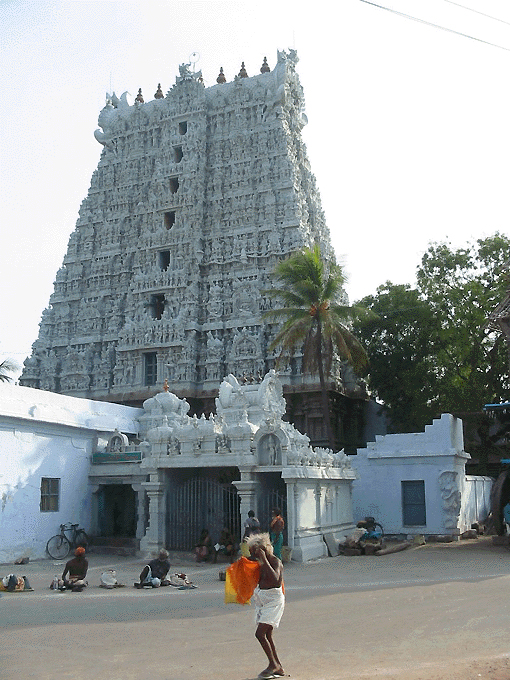
Temple Complex Lord Siva started from this place to wed Kanyakumari Amman, but returned when he heard the cockcrow. Thus, the Goddess Kumari resides here as a virgin, unable to marry Lord Shiva. Lord Indra became purified at the very spot where the temple now stands, thus the name 'Suchindram' comes from the word suchi, or purity. To this day, Indra is said to visit the temple each night to perform Ardhajama puja.
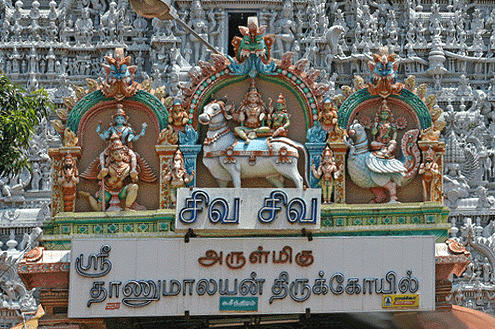
Temple Entrance (Lord Brahma on Hamsa is on the right) Suchindram Temple is approximately 1,300 years old. The temple construction took place over an extended period of at least six hundred years, so parts of the temple date back to the late 8th century, while others are 15th century. The earliest lithic records of Suchindram belong to the 9th Century A.D. Up until the time Kanyakumari became part of Tamil Nadu, the Suchindram Temple was under the administration of the Travancore Kings. Travancore at that time had its main temple at Padmanabhapuram, which was Vaishnavite. The Nanjil Pillais and other community members in Nagarcoil were primarily Shaivaites, probably due to influences from the Chola, Chera and Pandya kingdoms before the advent of Travancore kingdom. One of the unique aspects of Sichindram Temple is the presence of deities from all the religious sects: Vaisnava, Shaivita, and local Tamil cults like Amman and Kandan. Temple worship, however, is controlled by one of the main Namboodiri Braman families, the Thekkumon Madam. The presiding deities here, the Trimurti, gave the temple its name as Thanumalayan Temple. 'Sthanu' refers to Shiva, 'Mal' to Visnu, and 'Ayan' to Lord Brahma. The Trimurti deity is a linga, and the top, middle and base sections representing Shiva, Visnu, and Brahma respectively.
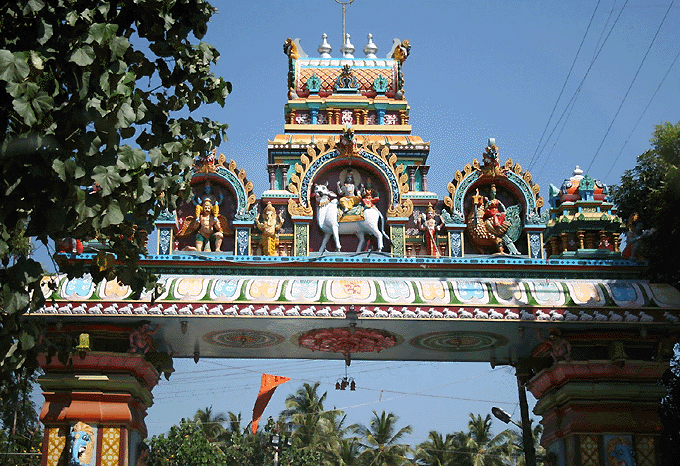
Temple gateway
Visitors arrive at Suchindram Temple by driving through an ornate temple gateway, then enter the temple compound on foot, crossing through a 24 foot high entranceway framed in brightly colored sculptures. The temple complex is encircled by a single corridor, making a very nice parikrama route. There are many mandapams at Suchindram, which house a great many deities and divine personalities. The main shrines and places of worship in the temple complex include the sanctum sanctorum in which Sthanu Mal Ayan, the presiding deities reside. There are some 30 additional shrines, including those for Lord Vishnu, Sita-Rama, Kailasanathar, Pancha Pandavar, Natakasala, Kontai Adi, Subramania Swamy, and Garuda, along with Unjal, Dwaja, Chenbagaraman, Vasantha, and Alankara Mandapam. There is also a Gopura Vasal, Nandeeswar shring, Chitra sabai, and the great Hanuman murti, all encircled by a temple corridor. The Theertham here is the Prapancha tank.
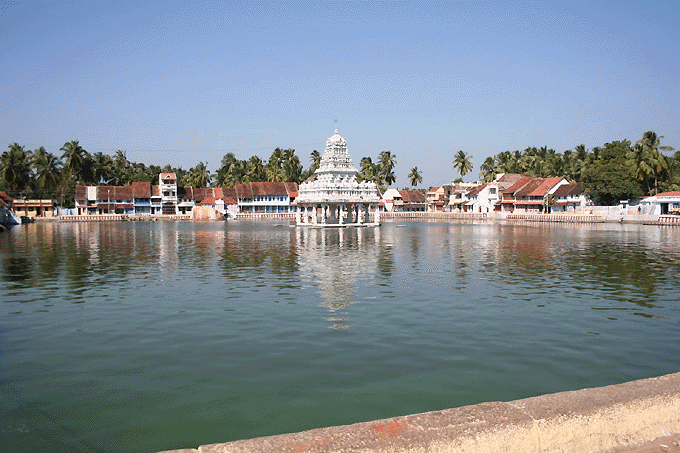
Prapancha Tank The Sanctum Sanctorum is illuminated by many oil lamps. The Trimurti linga is two and a half feet in height, usually dressed in either a silver or golden mask. The golden Kavacha has 27 stars, 14 lunar phases and naga adorning the crown. The main sanctum stands on the western side of the compound. The presiding deities are offered water, oil, flowers, milk, etc at regular times, and the priests are said to carry the bhoga and paraphernalia through an underground passage. Chenbagaraman Mandapam is filled with beautiful sculptures and 32 intricately sculpted pillars, carved more than 525 years ago. There is a Vigneswari murti here, images of Siva's 64 sacred adventures (Thiruvilaiyadal), and images depicting Sri Ramayana pastimes. The interior of the temple complex is heavily carved and ornamented throughout, with many scenes from the epic Ramayana and Mahabharata, including Bhagavad-gita scenes and a Viswaroopam murti. There is a rare image of Sri Krsna Parthasarathi in the form of the Trinity, in a Geethopathesa scene.
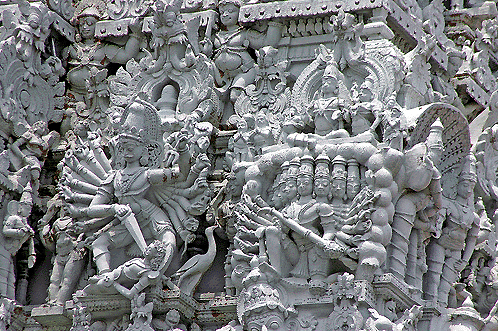
Detail of Gopuram carvings At the entrance to the main temple are two large temple guards, and on nearby pillars are two large yalis. Beside the sanctum sanctorum of Trimurti is the main Visnu shrine, where the Perumal deity is made of eight metals. To the right of it are the Sita-Rama deities, and across from them is the very tall Hanuman murti. To the left is Ganesh's shrine, in front of which is the Navagraha mandapa, carved into the ceiling. A Natakasala to the east has a big pavilion, now mostly used for preaching. The Kailasattu Mahadeva shrine in the southwest houses an ancient deity is Mahadeva from southern Kailasa. Next are the Vadakkedam and Tekkedam, shrines of Shiva and Vishnu respectively. They were in existence before the 10th Century A.D. Under the canopy of Naga, there are 16 moons (Chandrakala) of the idols, overlapping each other. Again, we find little mention of the separate Brahmadeva shrine, although it exists here. There rare female form of Vinayaka (Ganesha) here is known as Vigneshwari, or Vallabha Ganeshaani, as described in the Mantra Shastras. This Ganeshaani murti in sukhasana pose at Suchindram is one of only a few, the others being at a 10th century temple dedicated to 64 yoginis in Bheraghat, near Jabalpur, and one at the Tanumalaya Swami Temple in Suchindrum, Kerala. In Tibet, this female form of Ganesh is worshiped as Gajanani.
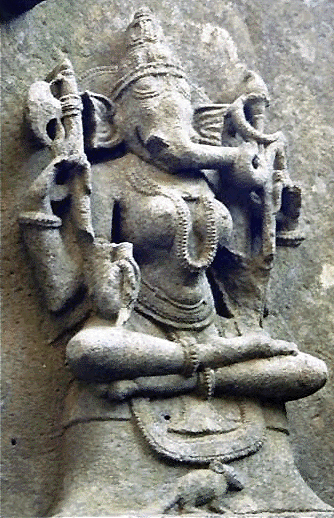
Vallabha Ganeshaani Another unusual feature at this temple is the Maakkalai, which houses a beautiful Nandi on the northern side of the temple. This impressive structure made of lime and mortar (chank powder) is 13 feet high, 21 feet long, and 10 wide, making it one of the largest of its kind. Nandi sits facing the sanctum, and is thought to be over 800 years old. Just behind the Nandi shrine is the Alankara Mandapam, which houses the famed 'musical pillars'. This magnificent hall houses four large pillars carved from a single stone, which branch out into smaller pillars. Two of them branch out into 33 small pillars, while the other two branch out into 25 smaller pillars. The pillars produce seven swaras, or musical notes, when tapped. There are another 1,035 carved pillars in what's known as the dancing hall.
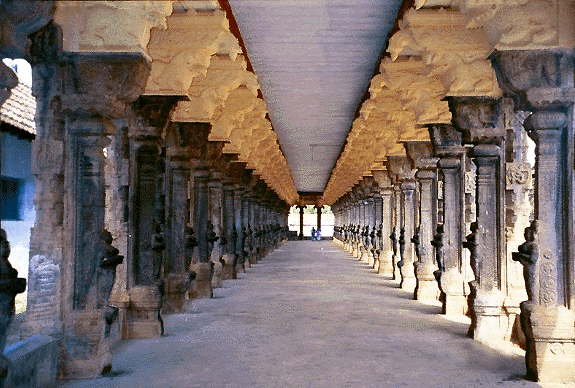
Pillared Hall Another famous feature of the temple is an enormous 22 foot tall figure of Hanuman, which is carved from a single block of granite. This towering Anjaneya sits at the eastern end of the north corridor. The history of Hanuman is quite fascinating. It was once buried in the temple, when the priests feared an attack by the Tippu Sultan sometime around 1740. Left underground for 190 years, it was eventually forgotten. One day many years later, in 1930, Sri M.K. Neelakanta Iyer, then Secretary of the Devaswom Board, known to be an extremely pious and honorable aristocrat serving under the Maharaja of Travancore, tripped and fell while circumambulating the temple. The Namboothiri brahmans were summoned and after a detailed study of Prasnam (astrological guidance), it was found that the Hanuman statue was buried at that place. Today, temple priests offer Hanuman puja with milk, sandalwood paste and kum kum, climbing a staircase to arrive at Hanuman's face. The deity is sometimes covered in butter and Vadai garlands. Hanuman's pose in this murti, with folded hands, is likely him tanding before Mother Sita in Ashoka Vanam.
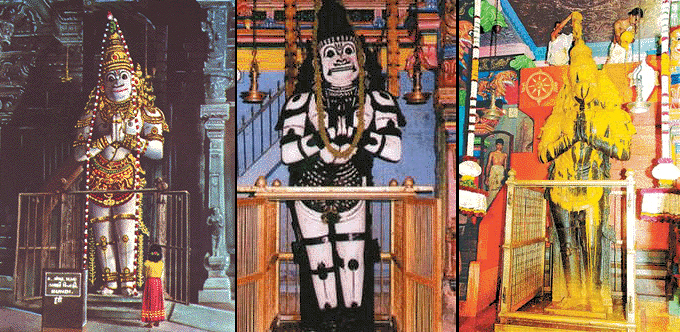
Sri Hanuman in various veshas Outside, there is an excellent collection of paintings found on the walls of the temple gopuram, which are now the aim of restoration and protection from local vandals. The approximately 115 paintings on the seven tiers of the tower are 120 years old, drawn onto the limestone walls using herbal extracts. Sometime after 1888, two kumbabhishekams (baths for the building) were performed, but no attempt was made to restore the paintings, but it is hoped will now become the focus of serious preservation.
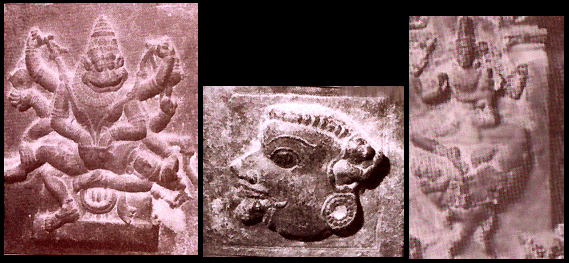
Temple Carvings Lord Nrsimha (left), Surabai (center), and Ravana (right) Another story of note about Suchindram Temple is the age-old practice of Agnipariksha that was practiced here up until the 1860's, when it was forbidden by the government. This ritual could only be engaged if the king gave his consent, and then it was done on a designated date. The ritual involves Kaimukkal, or 'dipping of the hand', in which any Namboothiri, or a high caste Brahmin who was under threat of excommunication due to immoral behavior, had to prove his innocence. A small silver ox statue was placed in a copper vessel of boiling ghee. The accused Brahmin had to reach in and pull the figure out of the ghee. A complex ritual followed in which the hand was bandaged, and the Brahmin taken to the home of a senior man, who watched over him. On the third day his hand was unwrapped. If the fingers were black and burned, the Brahmin was excommunicated, and pushed to the fringe of society. If his honor was vindicated, and the hand was normal, he was returned to his post, given gifts from the king, and all due respects were given to him by the temple community. One can only imagine the level of integrity required of Brahmins who faced such a method of oversight.
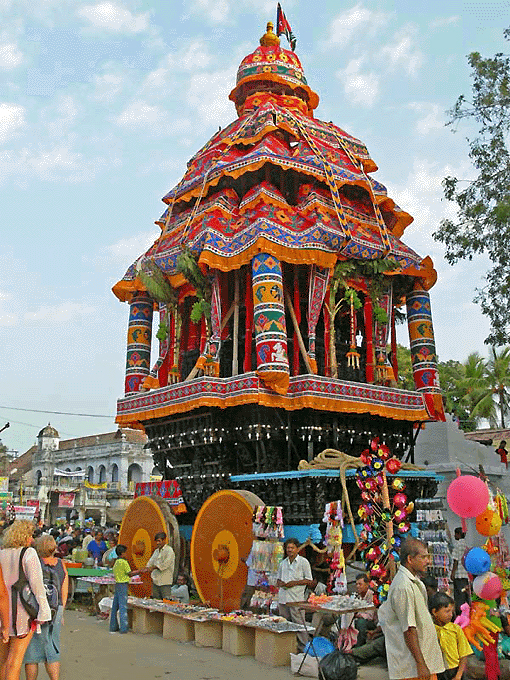
Temple Chariot
The chariots of Sthanu-Mal-Ayan temple are very beautiful, and the center of attractice at the annual Car Festival here. The chariots come out at the end of a 10-day festival, which begins on the day of Sathayam, in the month of Markazhi (December/January). Lakhs of devotees come to enjoy the festival. Another processional festival is held in Chiththirai (April/May), when the deities are taken out on the cars to give darshan to the devotees. While Their Lordships' original temple chariot was destroyed during the invasion of Khan Chanda Saheb, many devotees sacrificed their lives in protecting the remaining chariots, thus forcing the invaders to retreat. Afterwards, the Devi (Amman) car was made the major chariot. Each year it is accompanied by the chariots of Ganesa and Swamy, and each of the chariots bears one member of the Trimurti.
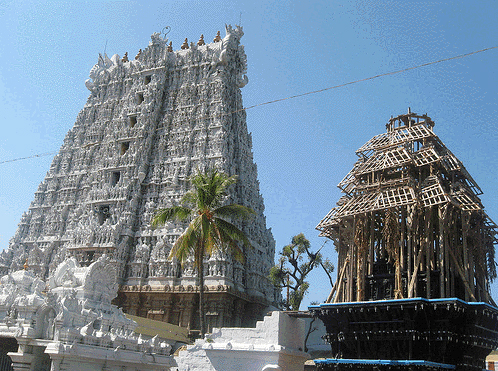
Temple Chariot base The chariot is made of wood and is carved with beautifully detailed sculptures, many of which feature the pastimes of Krsna and Rama lila. Each year, the upper portion of the car is remade with fresh poles and fabrics, and taken out on procession. There is a nice video of the festival here.
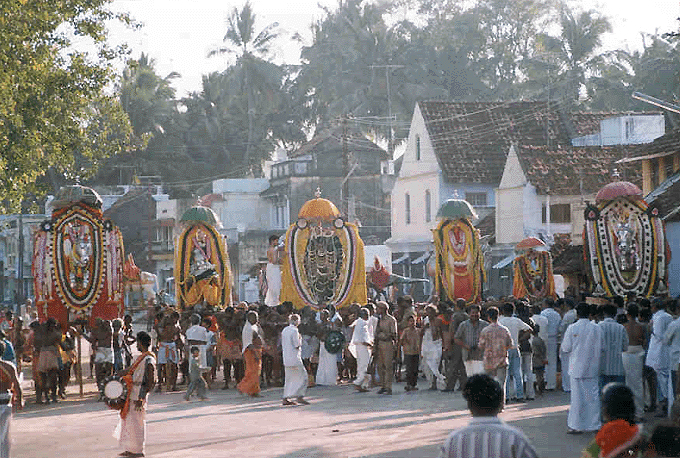
Panja Moorthy Tharisanam
| |
